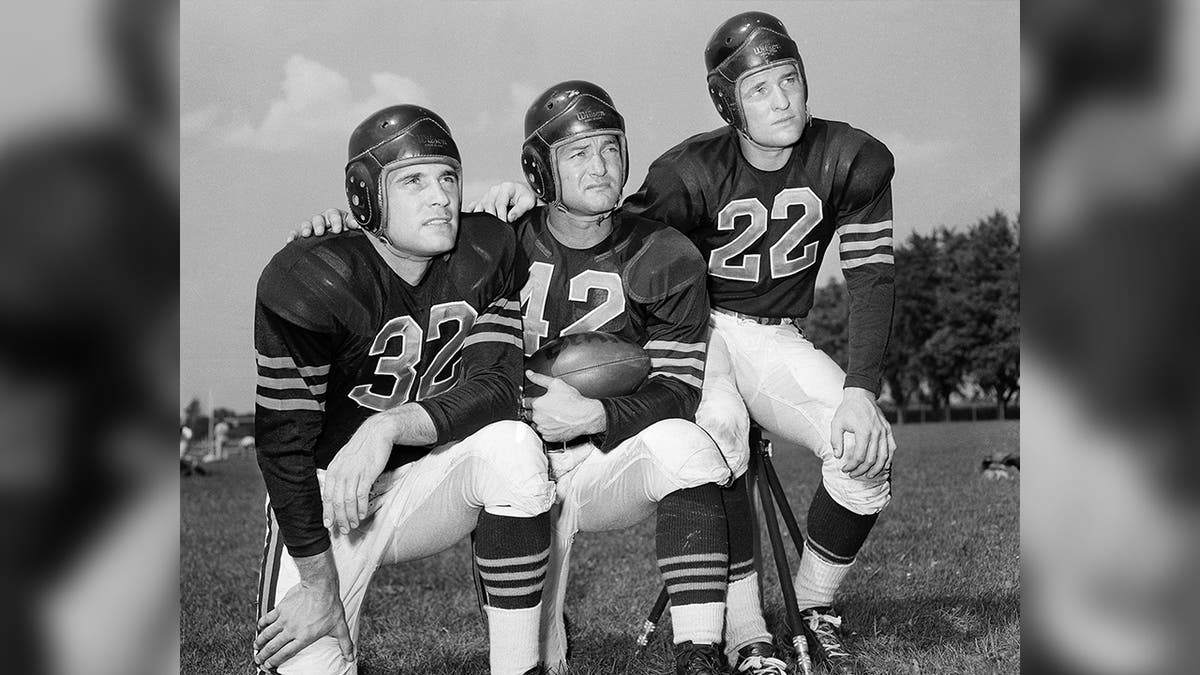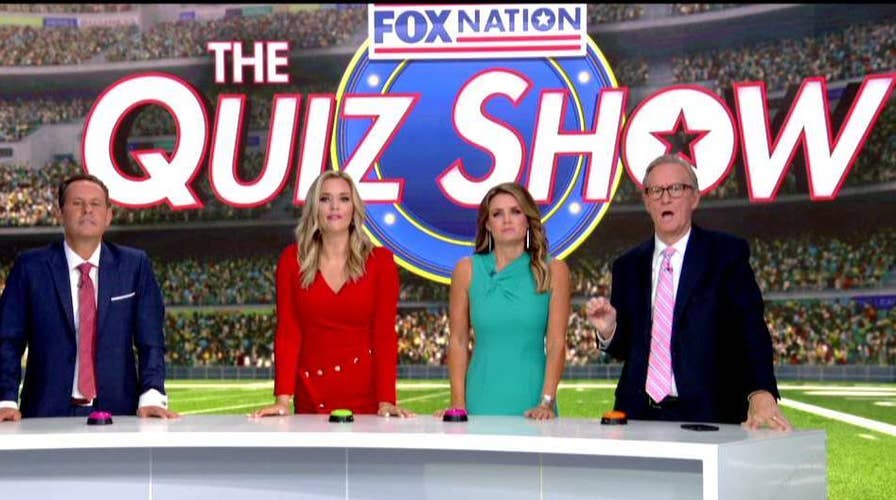Can you ace this NFL history quiz?
Fox Nation 'Quiz Show' host Tom Shillue brings a special NFL edition of the game to 'Fox & Friends.'
The NFL helmet, although never expected to fully prevent concussions or other head trauma, has in the last decade become a technological marvel.
Through a combination of technological advancements using cutting-edge materials and design elements, investment by the NFL and an open marketplace for development, today’s football headgear is rapidly evolving, The Associated Press reported.
“There is no question there has been significant success from the helmet manufacturer side in terms of building equipment that is more protective than it was four or five years ago,” NFL Executive Vice President Jeff Miller told The AP.

In this Sept. 16, 1971 , file photo, the powerful defensive front four of the Minnesota Vikings , from left, Jim Marshall, Alan Page, Gary Larson, Carl Eller pose during NFL football practiced in Minneapolis. (AP Photo/File)
The football helmet industry is a rapidly-growing market.
Some companies focus on the materials that provide padding and protection on the inside of the helmet. Others focus on the materials used for the outer shell. Some prioritize the face mask.
CLICK HERE FOR MORE SPORTS COVERAGE ON FOXNEWS.COM
And the four major brands -- legacy brands Riddell and Schutt, along with relative newcomers VICIS and Xenith -- put it all together, often using input from current players to create a design they want to wear, and provide a combination of maximum usability and safety.
“Competition is good for everybody. Competition keeps everybody moving fast, keeps everybody on their toes and wanting to bring new, better things to the field,” said Thad Ide, senior vice president of research and product development at Riddell.

In this Sept. 23, 2010, file photo, various football helmets, used for testing helmet-to-helmet collisions, are displayed on a rack at a laboratory in the Cleveland Clinic's Lutheran Hospital in Cleveland. (AP Photo/Mark Duncan, File)
Helmets have evolved from the original hard leather of the NFL’s infancy 100 years ago, to hard polycarbonate single-piece shells with various amounts of padding and air bladders that served as the primary form of head protection. Helmets again began to morph in recent years, taking advantage of emerging technologies and an increased focus on concussions.
“A couple of decades ago I think you would have had a hard time finding guys in the NFL or NCAA locker rooms who knew what helmet they were wearing. They just didn’t pay attention,” said Glenn Beckmann of Schutt Sports. “Now with all the attention and all the conversation and everything we’ve all learned as a society, as a sport, as a manufacturer, as an athlete, they realize it’s to their benefit to know what is going on and to use all this information to their advantage.”
The league itself put skin in the game to make players safer.
The NFL started its Head Health Challenge earlier this decade, awarding grants to promising technologies.

In this Aug. 25, 1948, file photo, veteran quarterback Sid Luckman, center, poses with two newcomers to the Chicago Bears, Johnny Lujack, left, and, Bobby Layne, during preseason football workouts at Collegeville, Ind. (AP Photo/File)
Four years ago, the NFL created what it calls an engineering road map specifically for helmets. The goal was to collect and analyze as much data as possible to map and track where helmet impacts were occurring and what types of impacts were causing head injuries, and have all that information shared with the helmet manufacturers.
“If we know where he [the player] is getting hit, where he is suffering impacts to his helmet, and they are in one or two focused areas on his helmet, then that helps manufacturers design helmets that have more protective attributes in that area,” Miller said. “We know when quarterbacks suffer head injuries, it’s most often to the back of their head because they’re getting sacked, frequently they’re clutching the ball and they’re not bracing themselves for impact, so the back of their head hits the turf. Why does their helmet look the same in the back as other players' [helmets] look in the back?”

FILE - In this Nov. 3, 2019, file photo, Denver Broncos running back Phillip Lindsay, center, is tackled by Cleveland Browns defensive tackle Sheldon Richardson, left, during the second half of NFL football game in Denver. (AP Photo/Jack Dempsey, File)
The league also created digital finite element models that allowed helmet manufactures the ability to recreate an unlimited number of helmet impacts based on the data collected by the league. This helps to discover new ways to reinforce or alter areas of the helmet that showed to be having repeated impacts.
CLICK HERE TO GET THE FOX NEWS APP
“Now that we have captured, collected, collated and analyzed it to share that information back to the helmet manufacturers, it’s easier for them to build models that better protect toward the sorts of injuries we see on field,” Miller said.
The Associated Press contributed to this report.





















